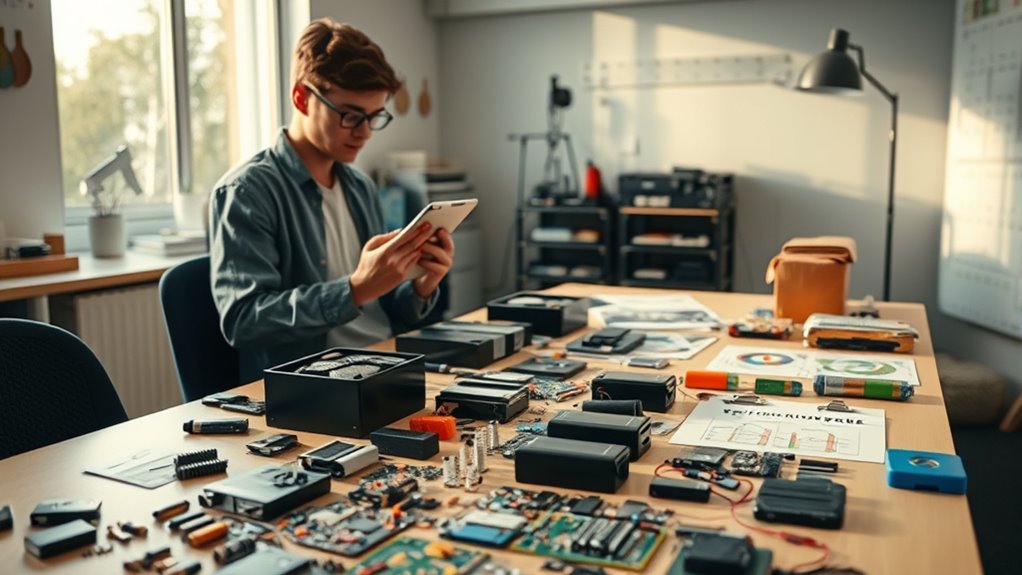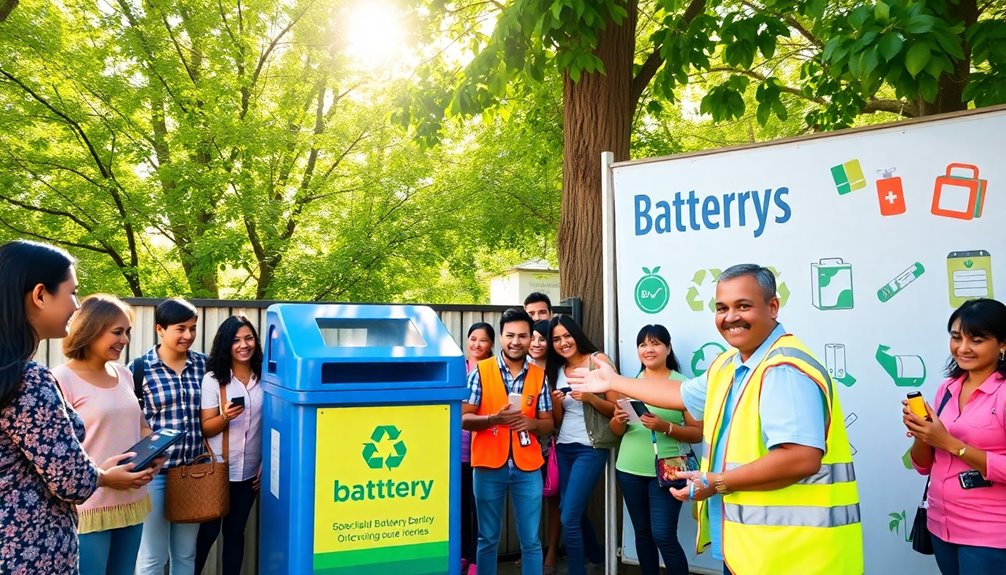Startups in the battery industry have major opportunities by focusing on recycling and second-life markets. You can develop innovative solutions to disassemble batteries easily, recover valuable materials, and reuse batteries for energy storage rather than disposal. By creating sustainable designs, you’ll help reduce environmental impact and tap into new revenue streams. Exploring these areas allows you to meet rising demand for eco-friendly energy solutions while building a competitive edge. Continue exploring to discover how these opportunities can shape your business future.
Key Takeaways
- Developing efficient recycling technologies enables start-ups to recover valuable materials and reduce environmental impact.
- Creating second-life applications extends battery lifespan, opening markets for stationary energy storage solutions.
- Innovative disassembly and reuse-focused designs facilitate easier recycling and material recovery, boosting sustainability.
- Partnering with OEMs and energy providers can accelerate adoption of recycled and second-life batteries.
- Investing in testing, safety, and management systems ensures reliable, safe reuse of batteries in secondary markets.

With the rapid growth of electric vehicles and renewable energy, battery start-ups are emerging as key players in the tech landscape. They’re not just advancing battery innovation but also tackling the complexities of supply chain management to meet soaring demand. As you explore opportunities in recycling and second-life markets, understanding how these companies are pushing boundaries becomes essential. Battery innovation isn’t limited to inventing new chemistries or increasing energy density; it also involves developing smarter, more sustainable ways to reuse and recycle existing batteries. By designing batteries with recycling in mind, these start-ups aim to reduce waste and lower the environmental impact of battery disposal. They’re creating technologies that facilitate easier disassembly and recovery of valuable materials, making recycling more efficient and cost-effective. This focus on sustainable design is critical because the lifespan of batteries in electric vehicles and energy storage systems is finite. Once they’ve reached their end of life, the challenge is to repurpose or recycle batteries rather than discard them. Emphasizing sustainable manufacturing practices is essential for scaling these solutions responsibly.
Battery start-ups innovate for sustainability by designing recyclable batteries and developing efficient disassembly technologies to reduce waste and environmental impact.
Supply chain management plays a pivotal role here. As you delve into this space, you’ll find that establishing reliable sources for raw materials like lithium, cobalt, and nickel is a constant challenge. Start-ups are forging new partnerships and exploring alternative supply routes to ensure a steady flow of materials. They’re also investing in local supply chains to reduce dependencies on geopolitically sensitive regions, which can cause delays and increase costs. Efficient supply chain management is vital for scaling up recycling operations and second-life applications, making sure that recovered materials and used batteries are quickly reintegrated into the ecosystem.
When it comes to second-life markets, these start-ups see tremendous potential in repurposing used EV batteries for stationary energy storage. Instead of letting batteries sit unused after their automotive life, they’re finding ways to give them a second lease on life. This not only extends the utility of the batteries but also offers a more affordable energy storage solution for renewable projects, grid stabilization, and backup power. You’ll notice that the economic viability of second-life batteries hinges on innovations that ensure safety, reliability, and performance. Start-ups are developing advanced testing, reconditioning, and management systems that guarantee these batteries can operate safely for years in new roles.
In essence, battery start-ups are transforming the industry by integrating cutting-edge battery innovation with strategic supply chain management. They’re creating sustainable pathways to recycle and repurpose batteries, opening up new markets and reducing environmental impact. As you consider entering this space, focus on how these innovations can be scaled up to meet global demand while maintaining safety, efficiency, and sustainability. The future of batteries isn’t just about new tech; it’s about smarter, more responsible ways to manage and reuse energy storage assets.
Frequently Asked Questions
What Are the Initial Capital Requirements for Starting a Battery Recycling Business?
You’ll need significant startup funding to launch a battery recycling business, mainly to cover equipment costs and facility setup. Initial capital requirements vary depending on your scale, but expect to invest hundreds of thousands of dollars for advanced shredders, separation tools, and safety systems. Securing sufficient funds early on guarantees you can acquire quality equipment, hire skilled staff, and meet regulatory standards, paving the way for sustainable operations.
How Do Regulations Vary Across Different Regions for Second-Life Battery Applications?
You’ll find regional standards and compliance frameworks vary considerably across different areas. In some regions, stricter safety and environmental regulations demand rigorous testing and certification for second-life battery applications, while others have more lenient rules. You need to thoroughly research specific regional standards to guarantee your business complies. Staying updated on evolving policies helps you avoid legal issues, build trust, and access markets more confidently.
What Technological Innovations Are Most Promising for Improving Recycling Efficiency?
You’ll find AI-powered sorting systems revolutionize recycling efficiency, increasing recovery rates by up to 30%. These innovations, combined with advanced hydrometallurgy, allow for precise extraction of valuable materials, reducing waste and energy use. Such technologies streamline processes, lower costs, and make second-life battery applications more viable, helping you stay ahead in sustainable battery management and creating a more circular economy.
How Can Start-Ups Effectively Establish Partnerships With OEMS and Suppliers?
To effectively establish partnerships with OEMs and suppliers, you should focus on clear partnership strategies that emphasize mutual benefits. Build strong relationships through transparency, consistent communication, and demonstrating your value in recycling and second-life markets. Prioritize supplier integration by aligning your goals with theirs, offering innovative solutions, and collaborating on technology development. This approach fosters trust, streamlines processes, and creates long-term alliances that support sustainable growth for your startup.
What Are Current Market Trends Influencing Demand for Recycled and Second-Life Batteries?
You should know that consumer awareness is driving demand for recycled and second-life batteries, with studies showing a 30% increase in eco-conscious purchases. As battery lifespan improves, more batteries reach end-of-life, creating a growing market for recycling and second-life applications. This trend reflects a shift toward sustainable practices, and your start-up can capitalize by offering innovative reuse solutions that meet these evolving customer expectations.
Conclusion
As you explore the evolving landscape of battery start-ups, you’ll find opportunities not just in innovation but in giving new purpose to existing resources. Embracing recycling and second-life markets gently guides you toward a more sustainable future, where challenges become opportunities in disguise. By thoughtfully steering these pathways, you can contribute to a cleaner world while building a resilient business. Ultimately, the path forward encourages you to turn potential into promise, quietly shaping a brighter tomorrow.









